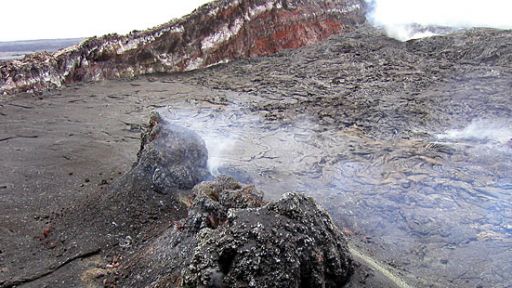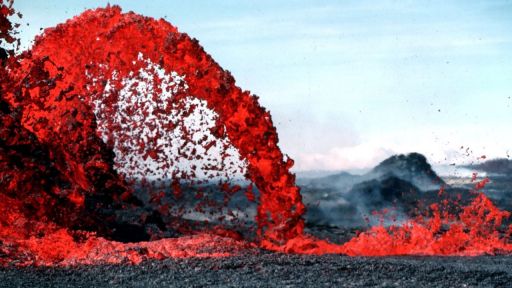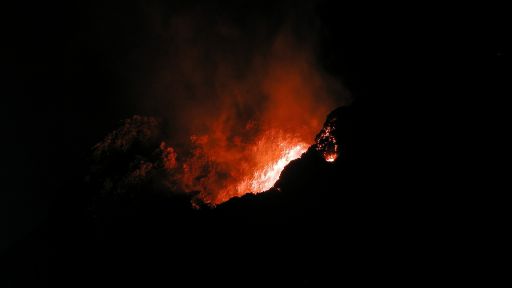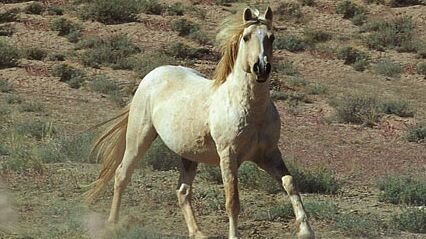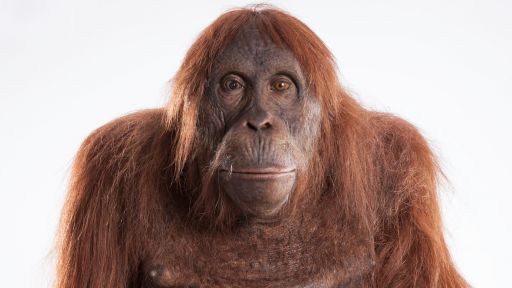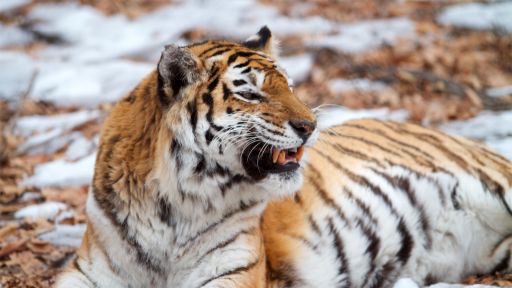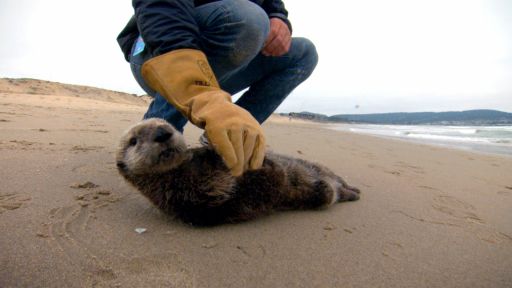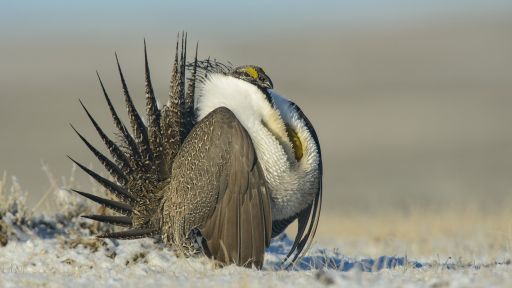TRANSCRIPT
[mournful music] - [James] Hawaii is a place of breathtaking natural beauty.
But it's no ordinary tropical paradise.
Hawaii has a dark side.
[foreboding music] From deep underground, an explosive inferno releases blazing torrents.
- And it's hot, the air's hot, the air's over 600 degrees goin' into there.
- [James] The islands are ravaged by fire and lashed by water.
- It's like liquid thunder.
Every wave can actually kill you.
- [James] The fury of nature is on display everywhere, on land, and in the sea.
- The competition is very, very intense.
If you're in the water with extremely active, aggressive animals, that can be also very scary.
- [James] In Hawaii, turbulent forces have conspired to create a paradise filled with perils.
[dramatic music] [inspiring music] [pensive music] Hawaii was born in fire.
Its islands spawned by volcanic eruptions.
And in some places, the fires still burn.
[ominous music] On the Big Island, the island named Hawaii, Kilauea spews forth molten rock in a daily spectacle of creation.
The volcano's newest cone, Pu'u o'o, has erupted almost continuously since it first appeared in 1983.
The steady flow of lava over two decades has added more than 500 acres to the island.
[suspenseful music] [chopper whirring] The landscape of Kilauea may seem alien and forbidding, but some find it irresistible.
This may be the best place on the planet to observe a long term eruption at close range.
Scientists come often to the floor of Kilauea's caldera, to take the pulse of the volcano.
Here the ground itself is hot and treacherous in danger of giving way to the lava that flows beneath.
Kilauea's lava can move fast, at well over 2,000 degrees Fahrenheit.
For geologists Carl Thornber and Tim Orr, today's mission is a daunting one: retrieving samples from a fresh batch of molten lava.
- Looks like we got some hot stuff up ahead.
- [James] They'll quench their samples in a coffee can filled with water.
Protective gear is minimal.
They rely more on expertise honed by years of experience.
- Okay.
Let's do it.
That's a nice breakout from this tumuli if we can get her right at the top.
Ooh, hot.
Not a little hot, it's really hot.
- [James] The lava is surrounded by a scorching shroud of superheated air.
- Ah, geez.
Come in from this side.
Oh, good floppy one.
- [James] Color and brightness are good indicators of temperature, but the heat reveals itself in other ways.
- That's hot enough to burn the hair off the top of your eyebrows.
And I certainly kinda got red cheeks after that one.
That was a hot one.
Rip it off.
Rip it up.
All right.
All right.
I got it.
Temperature's about 1150 degrees Centigrade.
That's what?
2100 Fahrenheit.
That's a lot hotter than you can get your kitchen oven, that's for sure.
And it's hot, the air's hot.
The air's over 600 degrees going into there, so you're walking into an oven.
So it's hard to get good samples, but when you need 'em, you get 'em.
We always get our samples, don't we, Tim?
- [James] The composition of the lava can tell them how and where it was formed.
- Come on, quench.
All right, you got the time?
- [Tim] It is 14:06.
- [James] It can also help in forecasting changes in the eruption.
- Put the rest of that in, okay.
- [James] Tiny fragments of lava reveal Kilauea's deepest secrets.
- We try to get a sample of lava as close to the vent every week, as close to the vent as we can get.
It allows us to get a feel for the long-term changes.
Whether the eruption's gonna stop or whether it's gonna continue, so we get a much better handle on what's gonna happen next.
- [James] Figuring out Kilauea's next moves isn't easy.
The volcano is always changing and seemingly inexhaustible.
[pensive music] Over the years, its flows have spread across the mountain, hardening into a variety of forms and textures.
Like a river in flood, the lava moves where it will, difficult to predict or control.
Since this eruption began in 1983, lava from Kilauea has rolled across the surrounding countryside.
[trees crashing] The lava's journey toward the sea was relentless and destructive.
For the residents of Kalapana, this was a disaster in slow motion.
They learned the hard way that wooden structures are no match for molten rock.
The invasion of Kalapana claimed more than 180 homes.
[fire crackling] Eventually the community was buried in a thick shroud of lava.
[reflective music] When Kilauea's flow stops, its destructive power is transformed: as it cools and hardens, everything in its path is enveloped in a prison of stone.
Although the Big Island reveals the most dramatic displays of volcanic power, every one of the Hawaiian islands bears witness to a fiery past.
The Hawaiian chain stretches for more than 1500 miles through the heart of the Pacific, the most isolated archipelago on earth.
In the southwest lie six main islands and two smaller ones, their rugged landscapes provide clues to the forces that shaped them.
[dramatic music] Time and tide.
Wind, water and fire.
They have sculpted Hawaii over millions of years.
Jagged cliffs, the remnants of extinct volcanoes, rise a thousand feet above the sea.
They testify to the combined power of erosion and seismic forces.
Magnificent canyons were created, when earthquakes twisted and split the landscape.
Giant craters are evidence of past eruptions and hint at new ones to come.
The most ancient volcanoes, worn down by the elements, now lie hidden beneath a carpet of green.
One of Hawaii's most famous landmarks, Diamond Head, looms above the beaches of Waikiki.
The sight is postcard perfect, but few realize that 10,000 years ago, this too was the scene of a violent eruption, as lava fountained from these walls and spilled into the sea.
Today, nearly half a million people live in its shadow.
Hawaii's volcanoes did more than sculpt the landscape.
They actually built the islands from scratch.
The Hawaiian chain sits atop the Pacific plate, a shifting block of the Earth's crust.
Beneath the plate lies a stationary hot spot.
It produces a column of magma, creating volcanoes that gradually rise above the sea to form islands.
As the plate slowly drifts northwest, each island in turn is pulled away from the hot spot, and the volcanoes are extinguished.
The hot spot now sits 20 miles south of the Big Island, where it's creating a new volcano named Loihi.
To see it, you have to head underwater.
Keeping an eye on the young volcano, scientists like Terry Kerby journey down in a manned submersible.
- We never know what we're gonna find from year to year.
This year there is a little more anticipation, because we heard that there was some seismic activity.
[expectant music] [suspenseful music] - [James] The slow descent to Loihi takes hours through waters that grow darker and colder.
Though the mountain has grown two miles above the seafloor its summit is 3,000 feet beneath the ocean's surface.
Inside a newly formed crater, the tiny submersible is dwarfed by Loihi.
Like any active volcano, Loihi is inherently unstable.
Seismic tremors in the interior can trigger landslides.
- I definitely am aware of what can happen down there.
We see these gigantic boulders down in the pit, wouldn't want to be down there when one of those things came down.
So we're always really tuned into any kind of sounds, any kind of vibrations.
[reflective music] - [James] A few species have adapted to this hostile environment, managing a precarious existence.
Beneath the rugged terrain, the same inferno that feeds Kilauea is constantly reshaping Loihi.
Delicate pencil chimneys rise from surfaces strewn with rubble.
Frequent earthquakes cause old structures to crumble, while new ones form.
- This is pretty amazing.
This is actually part of the wall that collapsed two years ago.
You can see the edge of it coming up here, a very sharp ridge that used to extend quite a ways further out, all that caved in and came down a couple of years ago.
- [James] As part of their routine survey, they'll check the volcano's temperature.
Vents in Loihi's flanks release blazing heat and dissolved gases.
- 60 degrees.
65 degrees.
- [James] The numbers steadily climb to well over 150 degrees Fahrenheit.
- That's amazing!
Think of it, the ambient water is almost freezing then there's vent water flowing out into this almost ice cold water that's 200 degrees Fahrenheit.
- [James] Scientists will continue to monitor the young volcano.
More earthquakes and collapses are inevitable.
Loihi will slowly rise from the ocean floor, finally breaking the surface thousands of years from now, to become the next Hawaiian island.
When it emerges from the sea, Loihi will be barren and lifeless, like every new volcanic island.
Yet even in this severe moonscape of frozen lava, spores and seeds blown by the wind, manage to take hold.
Tiny trees push through cracks in the surface, reaching for the tropical sun.
[gentle music] Wind and water quickly break down the lava into soil.
In just a hundred years, the bare flow can be transformed into a garden.
Here in the relative desert of the surrounding Pacific, Hawaii's rich volcanic soil has made the islands oases of fertility.
Sediments wash down to the coasts, and the islands' flanks provide purchase for coral reefs, the most bountiful of all marine environments.
The Hawaiian waters are a welcome refuge for a wide range of creatures many of them migrants.
[gentle music] The largest of all are humpback whales.
Each winter they arrive by the thousands from colder latitudes.
[whale singing] For the humpbacks, Hawaii is more than a warm winter getaway this is the perfect nursery.
Here in Hawaii, females can give birth and nurse their young in safety, free from the threat of killer whales.
The warm Hawaiian waters are an ideal place to gain weight on their mothers' milk.
Mother and calf are often accompanied by a second adult.
It was once believed this was a female, helping to rear the calf.
Now we know the escorts are always males.
And these charming creatures are revealing a darker, more aggressive side.
[expectant music] Scott Spitz has witnessed humpback aggression firsthand, observing them over 10 winters, off the coast of Maui.
- People have described humpback whales as gentle giants for many, many years, and they are extremely graceful animals.
But they're also very large powerful wild animals that compete just like any other animal does, for the things that are important, for resources.
And male humpback whales compete very aggressively for mating opportunities with females so the idea that they're gentle all the time is absolutely not true.
They do under the right circumstances engage in very, very aggressive behavior.
- [James] The humpbacks form large competitive pods of as many as 20 males, with a single female.
The males challenge each other to get close to the female, to win the right to become her escort, and perhaps her mate.
In the world of humpbacks, size definitely matters.
- [Scott] The largest whale is more likely to get the principal escort role or the dominant male role.
Whether or not that leads to reproduction we don't know.
No one has yet to see humpback whales mate.
But it certainly would be sensible that these whales are exerting all this energy and challenging each other for some significant reward.
[ethereal music] - [James] Many of the whales' challenges are almost imperceptible to humans, but their body language and subtle signals send a clear message to other whales.
And combat can turn brutal.
- [Scott] They compete by threatening each other with bubbles, by charging each other, and in the most severe situations by ramming into each other and physically forcing each other out of the way.
[tense music] [whale spouting] - [James] When a large group of males is involved, the competition heats up, and a series of duels can last for hours.
If two males of equal size square off, the battles can turn bloody.
[tense music continues] Fins and blowholes can be rubbed raw.
[tense music continues] As the spectacle plays out, females are not entirely passive.
They encourage the males to fight, or even signal a preference.
- Being in the water with these large animals is certainly intense if you're in the water with 10, 12, or 15 extremely active, aggressive animals that can be also very scary at times.
Whales are jostling for position, they're blowing bubbles.
There's decrease of the visibility.
They're moving very rapidly in unpredictable directions.
So you really never know exactly what you're gonna see when you get in the water with a competitive group.
There is always a chance that you're gonna be in the wrong place at the wrong time.
- [James] Like the islands themselves, the humpbacks' majestic beauty masks a ferocious power.
[dramatic music] There is another winter visitor to the shores of Hawaii, another giant with a violent side.
Storms as far away as Siberia hurl huge swells across the North Pacific.
When they finally break, the waves can rise 70 feet, propelled at more than 40 miles an hour.
It happens on the north shore of Maui, on a stretch of coastline called Pe'ahi.
Today, both the waves and the beach are known by a new name: Jaws.
Monster waves like these are seen only rarely, usually during the winter.
But the surf here is always dangerous and a team of lifeguards watches over Maui's beaches year-round.
- After you get that one posted, come back and get this one in.
- [James] Archie Kalepa is the head of ocean safety for Maui county and he's a top-rated surfer himself.
- It's definitely dangerous working there because of the imposing surf, the rugged coastline, the rocky shore.
Claire, is that Andy out there?
- [James] Archie knows the dangers of big waves, and their attraction.
- Once you've accomplished being in that environment, surfing those kind of waves, you kind of live for that moment and when it's not here that's all you can think about.
- [James] With the big waves just a few months away he's keeping an eye on Jaws.
- If you look you'll actually see some swells that are starting to come in and as those swells get closer to the shoreline you'll probably see some waves start developing as they get closer.
Still not, what we would consider as breaking, but it's a good indicator of the things to come this winter.
- [James] When the big waves arrive, they'll be unlike those that break anywhere else on the islands.
They're formed by the unique coastline at Jaws, lifted and amplified by an underwater ridge of lava and coral.
Incredible as it may seem, intrepid surfers journey from all over the world to take them on.
A ride at Jaws may last less than half a minute and the next crushing wave can break in a few seconds.
But surfers will risk their lives for the challenge.
- If you're gonna go out and surf that place, it goes far beyond training just to be able to surf.
You're training to survive.
It's an incredibly dangerous place to work.
[tense music] - [James] The waves at Jaws can swallow surfers and lifeguards in an instant.
The lifeguards train all year, to perform high-speed rescues in thundering surf.
- So you have to have good personnel that you can trust that you can work with, that has good communication.
Now we're gonna jump back in the water.
Once you break the surface I want you to tap your head and I want you to say "Clear!"
- Clear.
- Good.
Good job.
- [James] Archie puts his team through a grueling regimen, on the beach and in the ocean, to develop the strength and skills they'll need.
[suspenseful music] Wave runners and special rescue boards make their mission possible.
During these months of calm before the storms, they'll drill almost daily, perfecting their techniques and their timing.
- This is not Jaws, but it will be here.
And when it's here you'll know.
[gentle music] - [James] When winter comes to Hawaii, it will bring other changes high above the sea.
At nearly 14,000 feet, Mauna Kea, on the Big Island, rises above 40% of the Earth's atmosphere, making it ideal for observing the stars.
It's home to some of the world's most advanced telescopes.
The summit of Mauna Kea is usually barren and dry.
Most of the mountain's annual precipitation falls in the form of snow.
[tense music] In fact, blizzards are common in the winter.
Winds can top 70 miles an hour.
Roads become impassable and drifts leave observatories snowbound.
The summit may get more than four feet of snow in a single season.
Parts of the volcano are covered from December to May.
[pensive music] In mid-winter, the top of Mauna Kea no longer looks like Hawaii at all.
The ancient Hawaiians knew all about the volcano's uncommon climate.
That's why they named it Mauna Kea, "the white mountain."
But when a blizzard rages on Mauna Kea chances are good that, down at sea level, it's pouring.
Torrential storms are common here, and annual totals are often measured in hundreds of inches.
Rain can be both nourishing and destructive.
[water rushing] On these mountainous islands, water is always on the move, and it moves fast.
Waterlogged hillsides eventually give way, with disastrous results.
On Oahu, one community found itself in peril after tons of rock rolled down from the hills above.
Boulders narrowly missed the houses, and residents took the warning seriously, evacuating their homes.
[helicopter whirring] [dramatic music] To help prevent further disasters, crews went to work on the nearby slopes.
The loose rocks can't simply be removed but with luck and skill, they might be held in place.
The best solution is a veil of steel mesh to contain the hillside.
Helicopters do the heavy lifting, but a crew of scalers has to rappel down the uneven face of the slope, and stitch the net together.
Their work may keep the rocks in check here for a time.
But in Hawaii, erosion is part of the natural order.
What the volcanoes have built up, wind, water, and seismic forces will inevitably tear apart.
[foreboding music] You can see it on the Big Island, on the southwestern flank of Kilauea.
The great crack is an eight-mile-long fissure, up to 40 feet wide and 70 feet deep.
It opened during an eruption in 1823.
But its future remains unclear.
Some scientists believe this fracture might act like a giant hinge, detaching one part of the island from the rest.
Clues may lie hidden deep inside the crack itself.
Don Swanson is scientist-in-charge at the US Geological Survey's Hawaiian volcano observatory.
- It is pretty impressive to walk along the crack, it does remind you of something that's happened in the past that we haven't seen since, this big long crack opening and magma spewing out of it.
It must've been quite an impressive sight.
- [James] The interior of the crack is riddled with caves and crevices.
Many of them have never been explored.
- Three.
- [James] That's what lures Rick Elhard and Don Coons.
They're cavers who are spending their spare time mapping the great crack's internal structures.
- Once we get beyond two or three of these pitches, we know almost definitely that we're the first people to ever be there.
Wherever it takes us and whatever we find there we'll be the first people to discover it.
What I'm most interested in is all this rock stuff right over here oozing and dropping down the wall.
It's like candle wax.
That tells that activity from the volcano, from the caldera, hot molten magma flowed through this area at one time.
It's not just a broken tectonic crack, it was an active living part of the volcano.
- Whoo!
- All right, here we go!
[Don laughs] I'm on top of ya.
- Looks like a blow in hole to me Don.
- You can feel the draft from here.
Can feel the cold air coming straight down that slope.
Looks awesome.
I can look right into the darkness.
- You thought those were stiles, but kinda looks like ferns on there.
- [Don] Might be.
I don't know.
It's blowing enough air and I love that patina, that had flow.
- Something moved through there.
Oh!
Holy moly.
- [James] To gauge the depth of the cave, they'll use a technique that's simple but effective.
- [Don] Let's go.
Let's just tumble it and see what we can hear.
[rock rattling] Still rattling.
It's goin' down another 80-100 feet at least, on top of what we've already come down.
- Rappel into the abyss.
- [James] The only way to learn more is to follow the rocks into the darkness below.
- Oh my god, it's huge.
[suspenseful music] A monstrous big cave down there.
All right.
- [Rick] There's that scree pile we kicked down here.
- [James] This is the biggest cave they've ever seen in the great crack and it's the first time anyone has set foot here.
It may once have been a major artery, leading from the fiery heart of Kilauea.
- My left wall is about 15 feet, right wall's a good 30 feet away.
Ceiling, 25, floor, three.
Oh, I'm just making a quick sketch of the cave.
I'm doing a plan view right now and then we'll pick up a profile.
Basically just showing the contour of the ground, how it slopes down in one direction, up in another.
On point.
- 817.2.
- [James] Tracing the great crack's interior can help them understand how Kilauea has changed over time and how it might behave in years to come.
- Plane is minus six.
- Go the next station.
Move on.
- [James] Some believe a future eruption could cause the great crack to split further, perhaps causing the entire southern edge of the Big Island to slide away into the sea.
The Hawaiian landscape has undergone cataclysmic changes many times in the past.
Some of the islands are bordered by towering cliffs.
Far below, just offshore, lie vast deposits of rubble.
They provide clues to how these sheer cliffs were formed.
Walter Dudley is a geologist at the University of Hawaii.
- These enormous majestic cliffs behind me, for years have puzzled geologists, by their sheer size.
The normal rates of marine erosion just couldn't create these cliffs in the time that was available.
And it wasn't until the sea floor was mapped around it we discovered they weren't produced merely by marine erosion but by enormous landslides, where whole chunks of the island fell off into the Pacific Ocean.
- [James] Evidence of these giant slides can be seen all around the islands.
Scientists have identified at least 17 underwater rubble zones, covering thousands of square miles of seafloor.
- [Walter] For me to be able to stand at the top of these sheer cliffs, and realize that in one catastrophic event much of that coastline had fallen down and slid off into the Pacific Ocean.
Oh it's an awesome feeling, one is just amazed by the power of Mother Nature.
- [James] The events that left behind cliffs like these were no run-of-the-mill rock slides.
- The Hawaiian islands and every other volcanic island in the Pacific has been sculpted by the force of these landslides.
We're talking about an incredibly large volume of material, thousands of cubic kilometers of material, all at once, just like these masses behind me sliding off into the Pacific Ocean.
- [James] Such a huge amount of debris can displace an equally large volume of water, generating enormous waves, powerful tsunamis.
One of them occurred just over 100,000 years ago, when a section of the Kona coast on the Big Island collapsed.
It produced a giant tsunami that fanned out across the sea.
This mountain of water rose so high that it deposited coral and marine gravel on cliffs 1200 feet above the ocean.
Even a much smaller tsunami can be devastating.
These unstoppable walls of water are not at all like ordinary waves.
- If you've ever swum out into the ocean you know you can swim through surf.
But tsunami waves, the water is moving like a flood.
All the water is moving from the surface to the bottom, and that has the power to pick up boulders the size of cars, train locomotives have been picked up by tsunami waves and washed across town.
It's absolutely enormous.
Almost nothing can resist the power of these waves.
- [James] A tsunami can roll across the ocean at 600 miles per hour, like a bolt from the blue.
- They have no external warning signs.
When a hurricane is going to strike, the weather gets bad ahead of time.
There are warnings.
Before tornadoes strike, there's storms.
But you can be at the beach on a beautiful day and there's no indication whatsoever that a tsunami is traveling across the ocean to strike that beach.
- [James] Tsunamis can be triggered by coastal earthquakes as well as landslides, local quakes here in the islands, or distant ones off Alaska, Chile, or Japan.
Hawaii sits in the cross-hairs in mid-Pacific and tsunamis have killed more people here than any other natural disasters.
- One of the last large destructive tsunamis to strike the islands was in 1946, and in the town of Hilo alone 96 people were killed.
People on all the islands were killed by that tsunami, but for Hilo, it was the hardest area hit, it was an absolute catastrophe.
[waves crashing] [ominous music] [people yelling] - [James] The 1946 tsunami was generated by a quake in the Aleutians, and rolled across 3000 miles of ocean before slamming into Hilo.
- [Walter] It destroyed most of the buildings that fronted the ocean, and went in several blocks in some places.
It destroyed the railway.
The only buildings that weren't completely destroyed were those that were made of reinforced concrete and were away from the sea.
- [James] Today, an early warning system is in place offshore to save lives.
But Hawaii remains vulnerable.
- [Walter] On an average day it's been said that there are as many as 170,000 people at the beach, either in the water or lying on the sand.
They're all within three feet of the sea.
Even a five-foot tsunami wave could seriously endanger all of those people.
And if 10% became victims you'd have a disaster of enormous scale.
Imagine 17,000 casualties.
- [James] A five-foot tsunami would be bad enough but a much larger wave could be triggered by a local offshore earthquake or a large coastal landslide.
Within minutes, a wall of water could rise as high as 60 feet before plowing into a heavily populated beach like Waikiki.
The prospect is terrifying and all too real.
- As long as we continue to have earthquakes and landslides there'll be tsunami waves.
So it's certainly not a question of "if," it's a question of just when the next one is going to strike.
[ominous music] - [James] Fortunately, tsunamis don't happen that often, but large waves can be counted on to batter the Hawaiian coast.
Now winter has arrived on the islands, bringing with it high winds and high seas.
[reflective music] [waves crashing] At Peahi, Jaws is at full throttle.
Wave-hungry surfers are ready for it.
And so is Archie Kalepa.
[expectant music] - Jaws is here.
This is what we prepare ourselves for year after year after year.
Training we go through when the surf is small and the surf's medium and the surf's big.
Today it's here and we're gonna get firsthand experience.
We're gonna go on patrol.
Our guys are gonna see up close the magnitude and the power of Mother Nature and what it possesses.
[engine revving] [expectant music continues] It's gonna be a good day for our guys to be out there.
- [James] To save lives, the rescuers must be out where it counts, offshore, in the midst of the action in the heart of the monster surf.
[tense music] - The magnitude of the wave at Peahi is so enormous, it's like liquid thunder, the wave is like no other wave.
When I look at Jaws it brings fear, a heavy adrenaline rush, and it brings excitement, it's a feeling like no other.
All these thoughts are going through your mind.
You gotta be prepared physically, mentally, spiritually.
You gotta imagine yourself making it through every wave because every wave can actually kill you when Jaws is really happening.
- [James] Buzzy Kerbox is a professional big wave surfer and a Jaws aficionado.
- There's nothing like it, it's the Everest, it's the biggest, the ultimate.
You make mistakes out there and it's gonna let you know.
I've had some bad ones where I'm just getting ragdolled underwater, getting dragged and you don't know which way is up or you don't know, seems like you're just going with it, so it seems like it's never gonna end and then, eventually, you kind of get out of the grasp and can get up.
Um, what's scary is a lot of times, by the time you get up, the next one's right there so you get one breath, and you gotta be ready for another one.
[tense music continues] - [Archie] Maybe we weren't meant to surf Jaws because every wave that you ride out there, whether its 10 feet, or 20 feet, or 30 feet, it's life-threatening.
- [James] The lifeguards consider it a good day at Jaws when everyone makes it back to shore in one piece.
And their track record is spotless; they've never lost a surfer.
- It tingles my spine, it makes me feel good.
Breathing the salt air, being able to jump in the water.
The ocean is, for thousands of years, it's enabled the Hawaiian people to survive.
[pensive music] I feel really gifted to be a Hawaiian, to grow up here in Hawaii, and to have the ocean as my playground.
- [James] The big waves strike at Jaws only once or twice a year.
But on Kilauea, the lava never sleeps.
As night falls, the volcano, illuminated by its inexhaustible fires, reveals features that are hidden under the bright tropical sun.
Carl Thornber and Tim Orr often come here to observe Pu'u o'o after dark.
Seeking out new vents and monitoring the eruption.
The crater continues to evolve, as new flows scorch the surrounding landscape.
- We're observing one of the vents within the Pu'u o'o crater.
It's an opportunity to grab some of the samples of material that is beneath our feet here within the crater.
We want to keep an eye on this because activity could pick up pretty quickly.
The flames that are shooting are produced by hydrogen gas.
And every once in a while when this thing bubbles and churns, it sends a spit of spatter and it could be that it could really pick up.
Where do you want to put it, on the ridge in the front?
[suspenseful music] So we're waiting for a good spit.
We've got three or four samples of this.
- [James] Tiny shards of volcanic glass, called "Pele's tears", provide clues to the volcano's internal chemistry.
- So that's fantastic, these are fantastic samples.
But we don't want to hang around here too long.
- [James] The stunning displays of Kilauea belie its dangers.
[pensive music] - [Carl] Kilauea is not simply a tourist attraction.
It's a real hazard.
And you can see that when you're out here working.
It lends a perspective to what you consider to be paradise, the island of Hawaii, that most people don't appreciate.
- [James] Hawaii may be paradise, but it is prey to fearsome displays of nature's power.
Beneath the rapturous beauty and breathtaking landscapes there are signs of the turmoil that tore these islands apart, and put them back together again.
Hawaii was forged in fire, shaken by seismic upheavals, and lashed by the sea.
And yet, it is these violent forces that have made Hawaii a crucible of creation.
[pensive music continues] [dramatic music]

